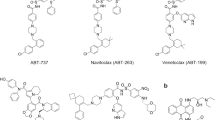Abstract
Recently, the heterocyclic compound 8-oxo-3-thiomorpholino-8H-acenaphtho[1,2-b]pyrrole-9-carbonitrile (S1) was synthesized and shown to induce apoptosis in both (H22) hematoma and (MCF-7) adenocarcinoma cells. The IC50 values of S1 against the two cell lines were 0.17 and 0.09 μmol/L, respectively. Furthermore, the apoptosis-inducing activity of this compound was highlighted both in vivo and in vitro. Subsequent experiments identified Bcl-2 as the primary target of S1, as a significant reduction in Bcl-2 protein levels was observed in H22 cells following a two-hour treatment with 10 μmol/L S1. While rapid depolarization of mitochondrial membranes led immediately to caspase 9 activation, no changes were identified in either caspase 8 levels or levels in Bcl-2 mRNA. These data were consistent with the results of circular dichroism (CD) spectra analysis, revealing that S1 inactivated the Bcl-2 protein by destroying its critical alpha helices. Taken together, these results suggest the potential of S1 in the development of new therapeutic agents.
Similar content being viewed by others
References
Sun S Y, Hail N Jr, Lotan R. Apoptosis as a novel target for cancer chemoprevention. Natl Cancer Inst, 2004, 96: 662–672
Thompson C B. Apoptosis in the pathogenesis and treatment of disease. Science, 1995, 267: 1456–1462
Cantley L C, Neel B G. New insights into tumor suppression: PTEN suppresses tumor formation by restraining the phosphoinositide 3-kinase/AKT pathway. Proc Natl Acad Sci USA, 1999, 96: 4240–4245
Chen X, Gao H, Wei P, et al. Expression of apoptosis-related genes Fas/FasL, Bax/Bcl-2 and Caspase-3 in rat corpus luteum during luteal regression. Sci China Ser C-Life Sci, 2003, 46: 273–285
Ashkenazi A, Dixit V M. Death receptors: Signaling and modulation. Science, 1998, 281: 1305–1308
Cochran A G. Protein-protein interfaces: mimics and inhibitors. Curr Opin Chem Biol, 2001, 5: 654–659
Huang Z. Exploring protein-protein interactions and the life and death of cells with small molecules. Chem Biol, 2002, 9: 1059–1072
Pindur U, Marotto A, Schulze E, et al. Functionalized and [a]-anellated carbazoles as potential B-DNA ligands: Experimental studies of DNA binding and molecular modeling of intercalation complexes. Pharmazie, 2000, 55: 727–732
Zhang Z, Yang Y, Liu F, et al. Acenaphtho[1, 2-b]pyrrole derivatives as new family of intercalators: Various DNA binding geometry and interesting antitumor capacity. Bioorgan Med Chem, 2006, 14: 6962–6970
Wu S P, Sun L Z, Willson J V K, et al. Repression of autocrine transforming growth factor Bl and B2 in quiescent CBS colon carcinoma cells leads to progression of tumorigenic properties. Cell Growth Differ, 1993, 4: 115–123
Charalampopoulos I, Tsatsanis C, Dermitzaki E, et al. Dehydroepiandrosterone and allopregnanolone protect sympathoadrenal medulla cells against apoptosis via antiapoptotic Bcl-2 proteins. Proc Natl Acad Sci USA, 2004, 101: 8209–8214
Gavrieli Y, Sherman Y, Ben-Sasson S A. Identification of programmed cell death in situ via specific labeling of nuclear DNA fragmentation. Cell Biol, 1992, 119: 493–501
Nakamuraa K, Araib D, Fukuchi K. Identification of the region required for the antiapoptotic function of the cyclin kinase inhibitor. Arch Biochem Biophys, 2004, 431: 47–54
Viktor G., Manuel H. Developing inhibitors of the epidermal growth factor receptor for cancer treatment. Natl Cancer Inst, 2003, 95: 851–867
Sami S M, Dorr R T, Solyom A M, et al. Amino-substituted 2-[2′-(dime-thylamino)ethyl]-1,2-dihydro-3H-dibenz[de,h] isoquinoline-1, 3-diones, synthesis, antitumor activity, and quantitative structure-activity relationship. Med Chem, 1995, 38: 983–993
Becattini B, Sareth S, Zhai D, et al. Targeting apoptosis via chemical design: Inhibition of bid-induced cell death by small organic molecules. Chem Biol, 2004, 11: 1107–1117
Greenfield N J. Methods to estimate the conformation of proteins and polypeptides from circular dichroism data. Anal Biochem, 1996, 235: 1–10
Veis D, Sorenson S, Shutter J, et al. Bcl-2-deficient mice demonstrate fulminant lymphoid apoptosis, polycystic kidneys, and hypopigmented hair. Cell, 1993, 75: 229–240
Enyedy I J, Ling Y, Nacro K, et al.. Discovery of small-molecule inhibitors of Bcl-2 through structure-based computer screening. J Med Chem, 2001, 44: 4313–4324
Author information
Authors and Affiliations
Corresponding author
Additional information
Supported by the National Natural Science Foundation of China (Grant No. 30400106)
Rights and permissions
About this article
Cite this article
Jin, L., Zhang, Z., Wang, Y. et al. A novel small molecule inhibitor targeted at Bcl-2. SCI CHINA SER C 50, 624–629 (2007). https://doi.org/10.1007/s11427-007-0079-0
Received:
Accepted:
Issue Date:
DOI: https://doi.org/10.1007/s11427-007-0079-0




